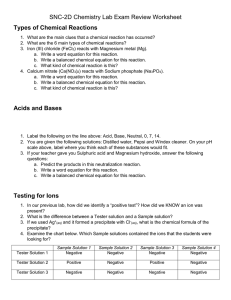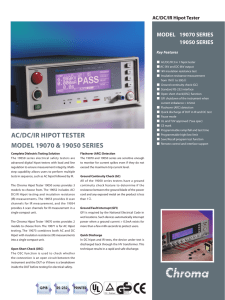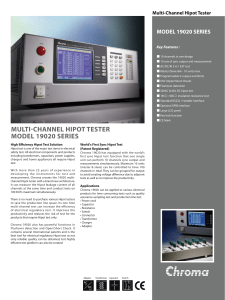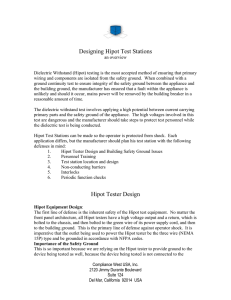Advantages of Safety Electrical Tester
advertisement
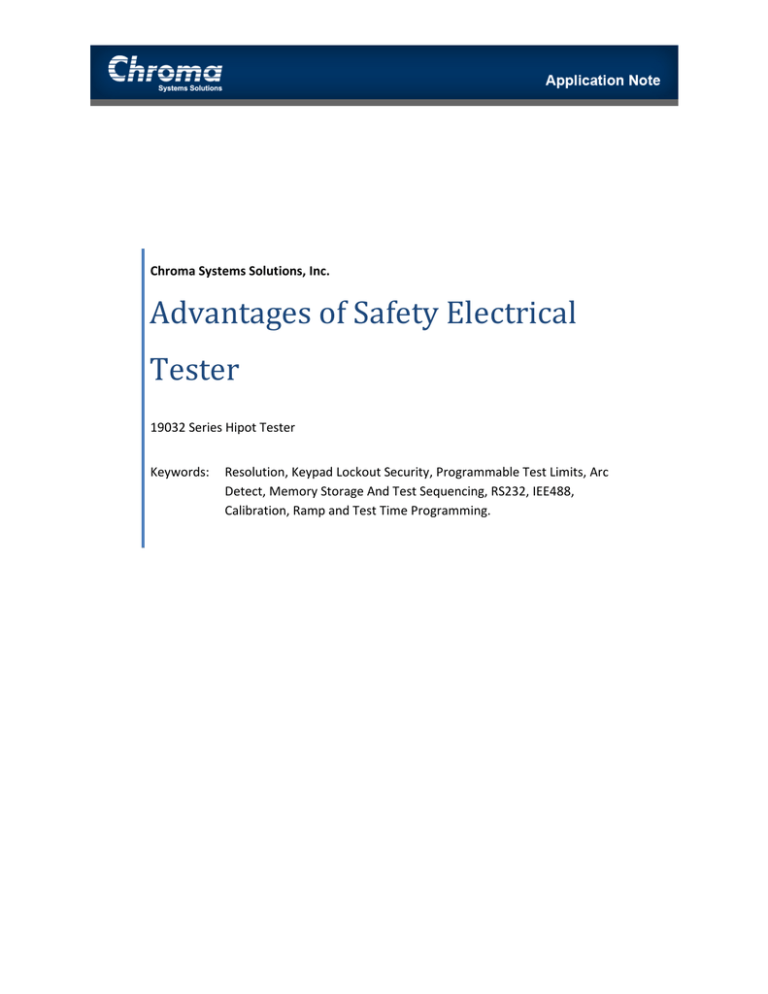
Chroma Systems Solutions, Inc. Advantages of Safety Electrical Tester 19032 Series Hipot Tester Keywords: Resolution, Keypad Lockout Security, Programmable Test Limits, Arc Detect, Memory Storage And Test Sequencing, RS232, IEE488, Calibration, Ramp and Test Time Programming. Application Note Title: Product Family: Advantages of Safety Electrical Tester 19032 Series Hipot Testers There are still many analog electrical safety testers in the field. However, a new generation of digital electrical safety testers offers many advantages over the analog variety. This note will specifically address these benefits, provide examples, and offer tips on how to introduce these products to analog users. Better Resolution Displays on the digital electrical safety testers are precise and easier to read. Digital displays leave no room for error as long as the tester is within calibration. The setting and measurement resolution on a digital device is also a major advantage. For programming, no dial settings or pot tweaking are required. Simply enter a digital value on the keypad. Viewing measurement data on a digital display eliminates guesswork. Simple, Menu-Driven Programming Here again, no pots to tweak, no dials to turn, and no guesswork as to proper tester configuration. The digital testers provide numeric keypads and up/down arrows to select and edit parameters. Simple as well as advanced features can be entered and edited with the ease of keypads and clear displays. In addition, many advanced and special features are provided as a by-product of a digital device. Such features include programmable rate of voltage rise, programmable time for PASS/FAIL indication, GPIB address, and selectable DC voltage for insulation resistance. Keypad Lockout Security Digital devices offer many security features, one of which is keypad lockout. Keypad lockout permits the supervisor to program and store one or more tests in the tester’s memory and then “lock out” the editable parameters. The technician need only recall a test from memory and use the START and STOP keys to run tests. This eliminates the risk of unauthorized and unsafe programming. A password limits access to edit screens. Programmable Test Limits Electrical safety tests include Hipot (with associated current sensing tests), Insulation Resistance, and Ground Continuity. Each of these tests permits the user to enter a series of limits with which the tester compares measurement data. The main advantage of digital over analog is in the sheer number of © Chroma Systems Solutions, Inc. Page 2 of 4 Application Note selections and the high resolution available. For example, an analog tester may offer a high current limit for a Hipot test where a digital device offers not only a high current detect, but a low current detect (which verifies that cables and/or DUT are connected before running a test), and arc current detect. Resistance limits for the Insulation Resistance test mode also benefit from the digital programming and sensing capabilities. Arc Detect Arc detect provides an extremely small window of time (1 to 10µsec typically) during which an electrical safety tester senses changes in current and anticipates a breakdown. This would be virtually impossible on an analog instrument. Memory Storage and Test Sequencing Digital instruments really shine when it comes to programming test sequences and then storing these sequences for later recall. A test sequence is simply a series of electrical safety tests that run from one to the next automatically. For example: a hipot test, then an IR test, and finally another hipot test. Depending on the instrument in question, many tests can be programmed, stored, and recalled. Using Chroma’s automatic test program, CaptivATE, you can make testing a quicker, safer, and more reliable phase of production. Figure 1. Guardian 6100 Plus Series Electrical Safety Analyzer Picture Shows Chroma 6100 Plus model which is equivalent to Chroma model 19032 Plus Leakage Current Scanner A190306 Automation and Digital Interfaces Digital interface capability, by definition, is a digital instrument’s claim to fame. The test program, CaptivATE, communicates via RS232. IEE488 is also available for communication to printer or scanner. Simple Calibration Calibrating a digital electrical safety tester couldn’t be easier. Almost no external equipment is needed and simple key presses are all that is required. Digital instruments typically require only one calibration per year. © Chroma Systems Solutions, Inc. Page 3 of 4 Application Note Ramp and Test Time Programming In order to perform safe, accurate, and appropriate electrical safety tests on devices, programmable ramp and test time capability goes a long way in eliminating waste (due to improper potentials) and complying with safety standards. Programmable ramp timing permits the user to apply potentials to a DUT at a fixed rate rather than hitting the DUT with the full potential all at once. With programmable test time capability the operator can enter precisely the times required by safety standards such as IEC60601. © Chroma Systems Solutions, Inc. Page 4 of 4


